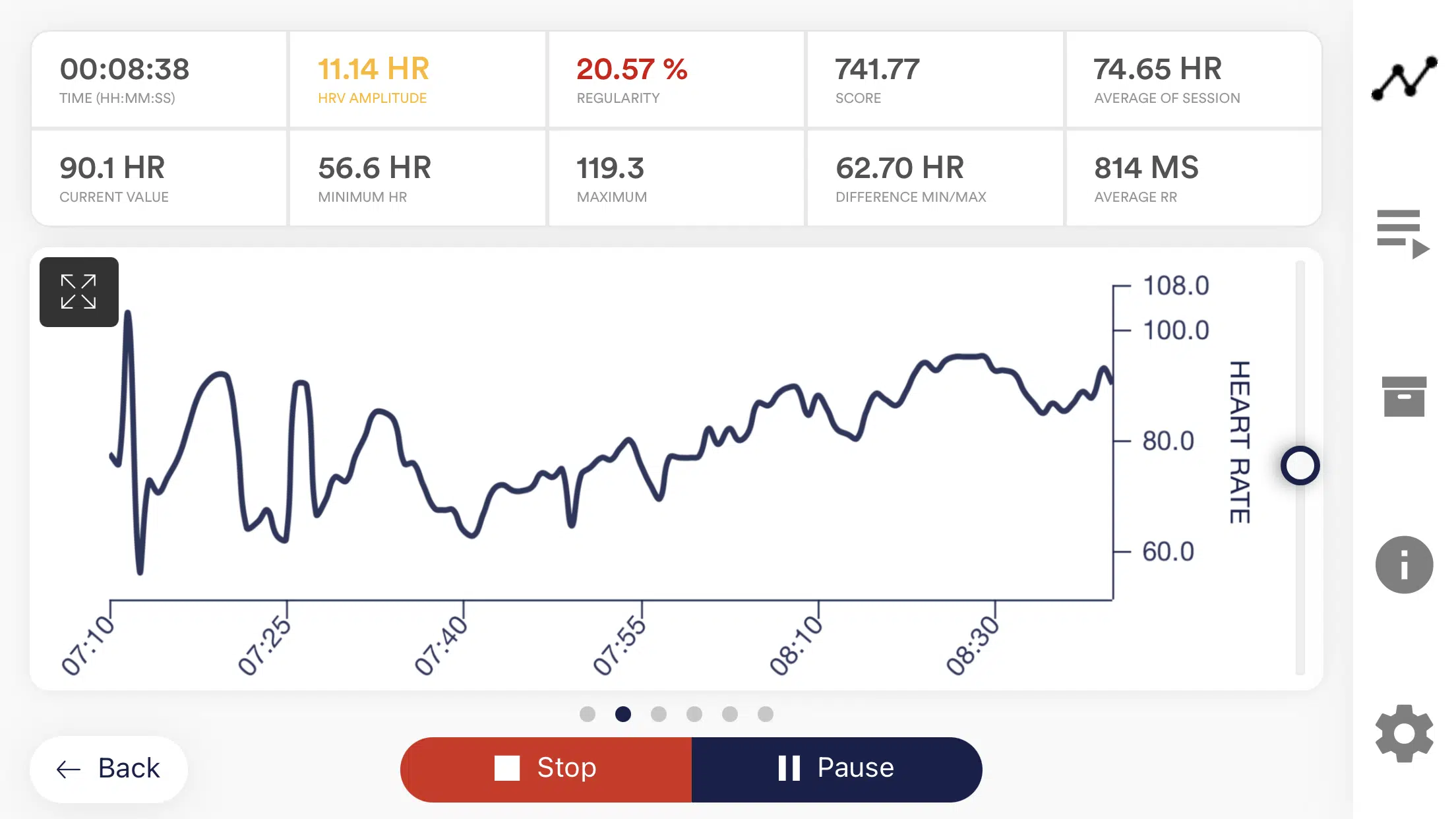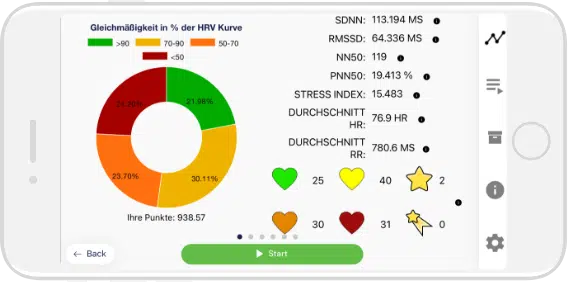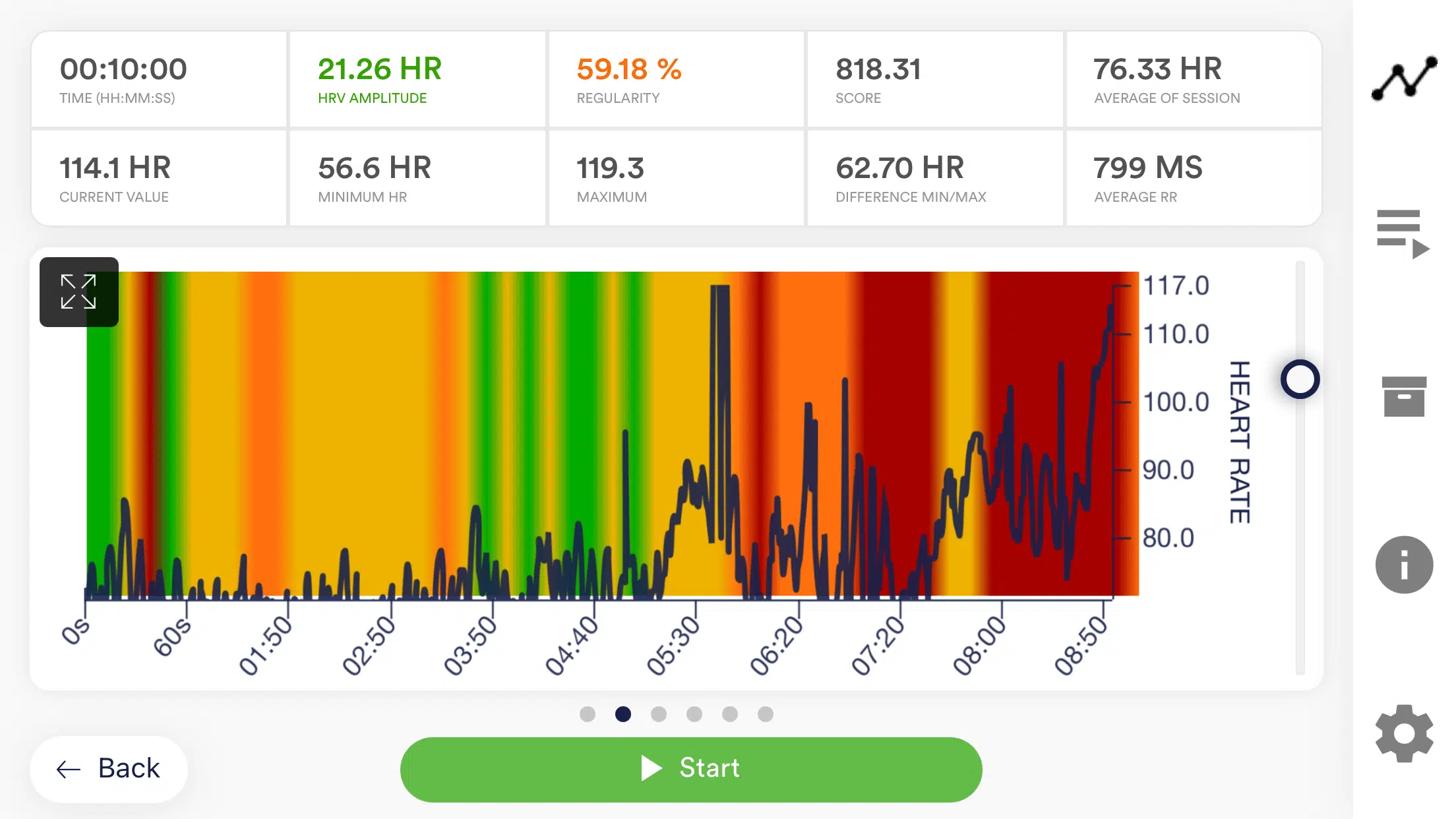
Heart Rate Variability (HRV) Definition
Heart Rate Variability (HRV) Definition
Heart rate variability (HRV) is the ability of an organism to change the frequency of the heart rhythm. Even at rest, changes in the temporal interval between heartbeats occur spontaneously. The body adjusts the frequency of the heartbeat in fractions of a second to meet changes in needs.
The body adjusts the frequency of the heartbeat in fractions of a second to meet changes in needs. Two essential components are the sympathetic nervous system, which activates and accelerates the heartbeat, and the parasympathetic nervous system, which acts as a brake and slows down the heartbeat. What do you think, is it a sign of vitality and health if the heart rate is very different? Or should the intervals between heartbeats be as equal as possible?
The adaptability of the heart rate
A healthy person constantly adjusts the heart rhythm to the momentary requirements. So the number of heartbeats per minute is constantly changing, this is a good sign of the adaptability of the organism. In addition to a physical load such as sports or physical work, psychological loads such as stress also result in an increase in the heartbeat. With relief and relaxation, the heart rate drops again. In us humans, heart rate variability ranges from 10 (low, a sign of (chronic) stress) to 30 (high, a sign of relaxation).
The more our organism is able to regulate the frequency of the heartbeat (the greater the heart rate variability), the healthier we are. If the heart beats only very rigidly, a person is about to die. Below you see an example of a low HRV.

Heart rate variability and biofeedback training
Our new eSense Pulse Sensor accurately measures heart rate variability, but is not intended for medical diagnosis and is not a medical device. With the eSense Pulse, we want to focus on biofeedback training, i.e. improving heart rate variability. To describe the current state and progress in training, our eSense app also provides the essential statistics and analysis of HRV. Other biofeedback data can also be visualized in this one app.
Long-term and short-term measurements of heart rate variability
For long-term measurements of heart rate variability, we also have the Faros 180 in our online store. Its small dimensions and light weight (20 grams) make it comfortable to wear on the body.
Both the measurements from the eSense Pulse and the Faros 180 can be excellently evaluated with the Kubios Scientific software. This is a popular software in the field of heart rate variability (HRV) and is used for both scientific research and professional use.
Heart Rate Variability – Our Heart in the Body
Our heart keeps us alive and performs tireless work throughout our lives. It is not for nothing that the rate of heartbeat in mammals is closely linked to the lifespan of the organism. The heart pumps blood through our body to ensure that oxygen-rich blood passes through all the components of our body and oxygen-poor blood is replenished with fresh oxygen in the lungs. But it also keeps everything moving, transporting nutrients, hormones, immune cells, etc.
The fact that our heart is beating is easy to recognize, you can feel its pulse or even hear it if you put an ear to another person’s chest. Since time immemorial, we have been studying and measuring the functions of the heart, and measuring the heartbeat is essential. However, the pulse itself is difficult to measure manually. Smartphone-supported devices that immediately generate statistics and diagrams, record everything effortlessly and, above all, work independently, make it possible to integrate measurements and, in some cases, biofeedback training into everyday life.
Heart Rate Variability Scores
- Frequency range: heart rate variability scores are measured in different frequencies, these include high frequency, low frequency and the very low frequency range. This can be used to obtain information about the nervous system.
- Normal range: there is no fixed normal range, this varies for each person and depends on their age, gender and physical fitness.
- Changes: Changes in heart rate variability scores can indicate improvement, or deterioration in the cardiovascular system. Of course, changes must be monitored over time for conclusions to be drawn.
- Insights for diseases: Regularly monitoring HRV levels allows you to effectively measure and track symptoms such as anxiety, sleep disturbances, and other responses from your body. Thus, you can check which measures really help you against diseases and stress.
What is a good Heart Rate Variability Score?
As already mentioned above, the scores are strongly dependent on the age and the health condition of the respective person. However, it can be stated that a high heart rate variability score is associated with a good adaptability of the heart to the autonomic nervous system. A low score means a low adaptability of the heart and is therefore also deficit. Individuals with a low heart rate variability score are more susceptible to stress and cardiovascular disease.
Generalizing, it can be claimed that higher HRV scores are good because they indicate better adaptability of the heart. What is a high and a low hearth rate variability score is again to be read in context, i.e. age, health status, gender and even more factors.
How can I increase my Hearth Rate Variability?
Increasing your heart rate variability is a great way to boost your health and lower your stress levels. You can train yourself to have a high HRV value so that your body is always well positioned against stress. In order for you to sustainably get a high HRV value, your parasympathetic nervous system needs to be increased. Our eSense Pulse can help you tremendously with this biofeedback training.
A good way to increase your heart rate variability is breathing exercises, here you breathe deeply in and out at different rates and thus increase the HRV value. With the eSense Pulse, you can track whether the breathing exercises are making a difference. Of course, the basics like a healthy diet and enough exercise should be right for you to increase your heart rate variability. Another important factor is your sleep quality, during sleep the autonomic nervous system is regulated and stress is relieved, make sure you get enough sleep to strengthen your heart.
Heartbeat in different phases
Depending on the situation, our heart is able to regulate the heartbeat. When we sleep, it usually beats slowly and steadily. When we exercise, it beats fast and constantly adjusts its frequency. Depending on the creature, the resting pulse changes: only six heartbeats per minute in a blue whale and 1000 heartbeats per minute in a shrew. We humans are in the lower range with about 60 heartbeats per minute. Infants have a faster resting pulse of about 130 beats per minute. Under great effort, our heart can also beat at over 200 beats per minute.
Biofeedback training can now be used to specifically measure, monitor and train heart rate variability. Direct feedback thus makes visible which activity influences the rate of the heartbeat and how. The current state as well as its change can be measured so well. In a typical training situation, whole-body relaxation can be produced through concentration, calm breathing, as well as and direct biofeedback, feedback via the heartbeat. But also strenuous situations such as high-performance sports can be controlled much better. Users can monitor their performance level very closely.

HRV Training Session Numbers
HRV biofeedback training in practice
In practice, a typical training session is characterized mainly by a constant cycle, a measurement-feedback-influence. These processes merge into one another, seem to merge with one another. However, a certain level of sustained concentration is required, which is why most training sessions do not exceed 30 minutes. In such a session, an attempt is made to train the influence of the central nervous system, on the heartbeat. This happens indirectly via calming and relaxation as well as tension and pressure.

HRV biofeedback training in practice
The beginning of the training – types of feedback
Before you start a training session, it is of great help to create appropriate framework conditions for the session. For your environmental parameters you should find the right balance: too warm is unsuitable, too cold, of course, after a great physical effort is similarly unsuitable as in half-sleep, where the ability to concentrate is not appropriate. The balance is important. Likewise, avoid distractions such as ringing phones or the like. These sources of interference must be minimized.
Now, breathing, audio-visual stimuli as well as pure concentration influence the rate of the heart. The individual units are divided into procedures. The feedback on how your heart is behaving is immediately displayed on a screen during biofeedback, but other biofeedback methods are also possible and used. A lamp that changes luminosity or color for feedback, a speaker that makes different sounds, … all these are ways to inform you about the change in heart rate.
